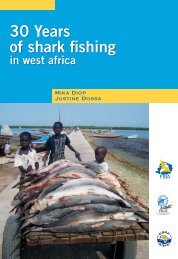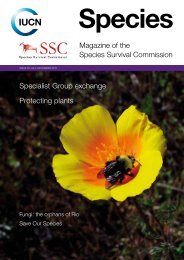Kyne & Simpfendorfer.. - Shark Specialist Group
Kyne & Simpfendorfer.. - Shark Specialist Group
Kyne & Simpfendorfer.. - Shark Specialist Group
Create successful ePaper yourself
Turn your PDF publications into a flip-book with our unique Google optimized e-Paper software.
ANNOTATED CHECKLIST OF EXTANT DEEPWATER CHONDRICHTHYAN<br />
FISHES<br />
Introduction<br />
Systematics and classification<br />
The following checklist contains all known described and undescribed deepwater species of<br />
the Class Chondrichthyes. The definition of a deepwater chondrichthyan is outlined in the<br />
general introduction of this report. The checklist is based largely upon Compagno and Duffy<br />
(2003) A checklist of deep water chondrichthyans of the world and Compagno (2005) Global<br />
checklist of living chondrichthyan fishes. Additionally, the present list contains recent species<br />
discoveries and descriptions, synonymy, and taxonomic changes and updates since<br />
preparation of the above-mentioned checklists, that is, up until January 2007. Primary<br />
literature (in the form of species descriptions and reviews), grey literature (in the form of in<br />
internal reports and conference abstracts books) and consultation with researchers possessing<br />
expert knowledge of taxonomic groups were used to update the checklist.<br />
Phylogeny and systematic arrangement of the checklist follows Compagno (2001, 2005) with<br />
the Holocephali here presented first, followed by the squalomorph sharks (incorporating the<br />
batoids) and finally the galeomorph sharks.<br />
Two of the notable discrepancies arising from following Compagno (2001, 2005) between the<br />
present checklist and other classifications concern the batoids. Firstly, several authors classify<br />
the batoids into numerous orders, but these are here considered suborders within the order<br />
Rajiformes. Suborders are not specified in the present checklist but these can be obtained<br />
from Compagno (2005). Secondly, the systematics and classification of the skates (suborder<br />
Rajoidei) is among the most complex and unresolved and the softnose and hardnose skates<br />
are often classified into two subfamilies within the single family Rajidae: the<br />
Arhynchobatinae (softnose skates) and the Rajinae (hardnose skates). However, these are here<br />
referred to as the families Arhynchobatidae (softnose skates) and Rajidae (hardnose skates).<br />
Differences in the systematics and classification in the present list to that in Compagno (2005)<br />
concern recent systematic updates and these are briefly summarised as follows. 1). The<br />
classification of the Australasian skate fauna follows Last and Yearsley (2002) (with the<br />
exception of familial classification) along with recent descriptions (i.e. New Zealand<br />
Brochiraja; Last and McEachran 2006); 2). Whereas Compagno (2005) placed several<br />
Southwest Atlantic and Southeast Pacific Bathyraja into Rhinoraja they are here retained in<br />
Bathyraja due to a lack of explanation for their placement in Rhinoraja; and, 3). The<br />
systematics of the Indo-West Pacific Centrophorus are currently under review and this is<br />
reflected in the checklist (W. White pers. comm.).<br />
The scientific name of each species is followed by the authority and year of publication for<br />
the description of that species. Parentheses around the authority and year indicate that the<br />
species name has changed since the original description. For example, the smallspine<br />
spookfish Harriotta haeckeli was described by Karrer in 1972 as the binomial name Harriotta<br />
haeckeli and is thus referred to as Harriotta haeckeli Karrer, 1972. The sicklefin chimaera<br />
Neoharriotta pinnata however, was originally described by Schnakenbeck in 1931 as<br />
Harriotta pinnata before being reassigned to the new genus Neoharriotta; it is thus referred to<br />
as Neoharriotta pinnata (Schnakenbeck, 1931). Where a species has not yet been formally<br />
described, that is, it has not been given a specific name and its description has not been<br />
published, it is often assigned a temporary letter or numerical code followed by a name of the<br />
researcher or publication which identified the species as distinct and new, and whom may be<br />
working on the relationship of this species to its congeners and ultimately its description. An<br />
15
















